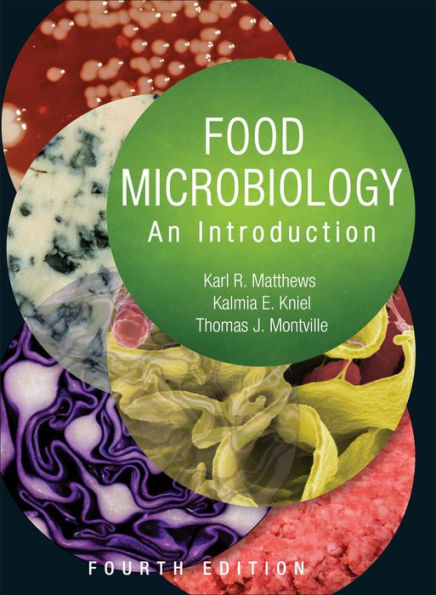Food Microbiology: An Introduction / Edition 4 available in Hardcover

Food Microbiology: An Introduction / Edition 4
- ISBN-10:
- 1555819389
- ISBN-13:
- 9781555819385
- Pub. Date:
- 03/21/2017
- Publisher:
- Wiley

Food Microbiology: An Introduction / Edition 4
Buy New
$113.15Buy Used
$99.99
-
SHIP THIS ITEM— Not Eligible for Free Shipping$99.99
-
SHIP THIS ITEM
Temporarily Out of Stock Online
Please check back later for updated availability.
-
Overview

About the Author
Kalmia E. Kniel is a professor of microbial food safety in the Department of Animal and Food Sciences at the University of Delaware She received her PhD from Virginia Tech in Food Science and Technology in 2002. Her doctoral work focused on protozoan parasites. After that, she was a postdoctoral microbiologist at the USDA Agricultural Research Service's Animal Parasitic Diseases Laboratory. She is nationally recognized as a leading expert in transmission of viruses, protozoa, and bacteria in the preharvest environment. Dr. Kniel has been active in researching the mechanisms behind the survival and inactivation of norovirus, hepatitis A virus, and other enteric viruses in our water and foods. She is an active advocate for teaching food safety at all levels and has been involved with elementary and secondary education. At the University of Delaware, she teaches courses on foodborne outbreak investigations and the basics of food science and food safety from farm to fork.
Thomas J. Montville is a distinguished professor emeritus at Rutgers University, where he received his BS in 1975. Dr. Montville received his PhD from the Massachusetts Institute of Technology (MIT) and then worked at the U.S. Department of Agriculture (USDA) as a research microbiologist before returning to Rutgers as a professor. He has published over 100 research papers on Clostridium botulinum, Listeria monocytogenes, antimicrobial peptides, and Bacillus anthracis. Dr. Montville is a fellow of the American Academy of Microbiology and a fellow of the Institute of Food Technologists.
Table of Contents
Preface xvAbout the Authors xvii
SECTION 1 BASICS OF FOOD MICROBIOLOGY
Chapter 1 The Trajectory of Food Microbiology 3
Chapter 2 Microbial Growth, Survival, and Death in Foods 13
Chapter 3 Spores and Their Significance 49
Chapter 4 Detection and Enumeration of Microbes in Food 69
Chapter 5 Rapid and Automated Microbial Methods 81
Chapter 6 Indicator Microorganisms and Microbiological Criteria 99
SECTION 2 FOODBORNE PATHOGENIC BACTERIA
Chapter 7 Regulatory Issues 121
Chapter 8 Bacillus cereus 145
Chapter 9 Campylobacter Species 157
Chapter 10 Clostridium botulinum 167
Chapter 11 Clostridium perfringens 189
Chapter 12 Enterohemorrhagic Escherichia coli 203
Chapter 13 Listeria monoctyogenes 223
Chapter 14 Salmonella Species 243
Chapter 15 Shigella Species 261
Chapter 16 Staphylococcus aureus 271
Chapter 17 Vibrio Species 285
Chapter 18 Yersinia enterocolitica 297
SECTION 3 OTHER MICROBES IMPORTANT IN FOOD
Chapter 19 Lactic Acid Bacteria and Their Fermentation Products 311
Chapter 20 Yeast-Based and Other Fermentations 327
Chapter 21 Spoilage Organisms 343
Chapter 22 Molds 373
Chapter 23 Parasites 391
Chapter 24 Viruses and Prions 427
SECTION 4 CONTROL OF MICROORGANISMS IN FOODChapter 25 Chemical Antimicrobials 457
Chapter 26 Biologically Based Preservation and Probiotic Bacteria 475
Chapter 27 Physical Methods of Food Preservation 489
Chapter 28 Nonthermal Processing 507
Chapter 29 Sanitation and Related Practices 527
Critical Thinking Skills 549
Useful Websites for Food Safety Information 553
Glossary 555
Answers to Crossword Puzzles 565
Answers to Selected Questions for Critical Thought 567
Index 585
